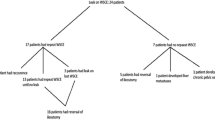Abstract
Purpose
Interpretation of water-soluble contrast enema following laparoscopic low anterior resection can be very challenging for both radiologists and colorectal surgeons. Discriminating the radiological appearances secondary to anastomotic configuration from those caused by actual anastomotic dehiscence is a common problem and may be made worse with the advent of laparoscopic surgery. The aim of this study is to identify potential novel appearances of the water-soluble contrast enema (WSCE) images of rectal anastomosis following laparoscopic low anterior resection to radiologists and surgeons.
Methods
We enrolled 45 patients who underwent laparoscopic low anterior resection with proximal de-functioning loop ileostomy within a specialized colorectal unit. The water-soluble contrast enema reports were reviewed. Two blinded colorectal radiologists independently reviewed the images of patients suspected of anastomotic leak. All of these patients also underwent a flexible sigmoidoscopy to confirm or exclude anastomotic leak before reversal of loop ileostomy. Inter-observer concordance was calculated.
Results
Seven out of eighteen patients (38.9%) were found to have true anastomotic leaks on flexible sigmoidoscopy (15% overall leak rate). In the remaining eleven patients the image appearances were attributed to the appearance of the anastomotic ‘dog-ear effect’, created by the anastomotic configuration due to multiple firing of the intra-corporeal laparoscopic stapling device. Radiologist inter-observer concordance was 83%. Sensitivity was 100%, specificity 71%, positive-predictive value (38.9%) and negative-predictive value (100%).
Conclusions
The novel appearances of laparoscopic-stapled rectal anastomoses in WSCE can be mistaken for anastomotic leak. To avoid delay in reversal of ileostomy, a flexible sigmoidoscopy can be used to confirm or exclude a leak.






Similar content being viewed by others
References
Taflampas P, Christodoulakis M, Tsiftsis DD (2009) Anastomotic leakage after low anterior resection for rectal cancer: facts, obscurity, and fiction. Surg Today 39(3):183–188
Walker KG, Bell SW, Rickard MJ, et al. (2004) Anastomotic leakage is predictive of diminished survival after potentially curative resection for colorectal cancer. Ann Surg 240:255–259
McArdle CS, McMillan DC, Hole DJ (2005) Impact of anastomotic leakage on long-term survival of patients undergoing curative resection for colorectal cancer. Br J Surg 92:1150–1154
Den Dulk M, Marijnen CAM, Collette L, et al. (2009) Multicentre analysis of oncological and survival outcomes following anastomotic leakage after rectal cancer surgery. Br J Surg 96(9):1066–1075
Bokey EL, Chapuis PH, Fung C, et al. (1995) Postoperative morbidity and mortality following resection of the colon and rectum for cancer. Dis Colon Rectum 38:480–487
Brannigan AE, De Buck S, Suetens P, Penninckx F, D’Hoore A (2006) Intracorporeal rectal stapling following laparoscopic total mesorectal excision: overcoming a challenge. Surg Endosc 20(6):952–955
Williams LA, Sagar PM, Finan PJ, Burke D (2008) The outcome of loop ileostomy closure: a prospective study. Colorectal Dis 10(5):460–464
Nicksa GA, Dring RV, Johnson KH, et al. (2007) Anastomotic leaks: what is the best diagnostic imaging study? Dis Colon Rectum 50(2):197–203
Karsten BJ, King JB, Kumar RR (2009) Role of water-soluble enema before takedown of diverting ileostomy for low pelvic anastomosis. Am Surg 75(10):941–944
Habib K, Gupta A, White D, Mazari FA, Wilson TR (2015) Utility of contrast enema to assess anastomotic integrity and the natural history of radiological leaks after low rectal surgery: systematic review and meta-analysis. Int J Colorectal Dis 30(8):1007–1014
Khair G, Alhamarneh O, Avery J, et al. (2007) Routine use of gastrograffin enema prior to the reversal of a loop ileostomy. Dig Surg 24(5):338–341
Lewis OA, McCallum IJ, Dixon S, Katory M (2015) Long-term -ostomy as a quality marker: comparison of outcomes from a 6 year series of laparoscopic surgery in MRI defined low rectal cancer. Int J Sur 23:108–114
Acknowledgments
Dr. Christopher Dennison, Consultant Radiologist, Queen Elizabeth Hosital Gateshead for the application of the water-soluble contrast enema technique.
Authors contribution
Mark Katory MD FRCS: Conception and design, acquisition of data, analysis and interpretation of data; and final approval. Ross McLean MRCS: Interpretation of data; and final approval. Khalid Osman PGCMEd FRCS: Conception and design, drafting the article and final approval. Mukhtar Ahmad, MMedSci, FRCS: Conception and design, acquisition of data, drafting the article and final approval. Tracey Hughes FRCR: Acquisition of data and revising it critically and final approval. Mike Newby FRCR: Acquisition of data and revising it critically and final approval. Christopher Dennison FRCR: Acquisition of data and revising it critically and final approval. Paul O’Loughlin FRCS: Analysis and interpretation of data; revising it critically and final approval.
Author information
Authors and Affiliations
Corresponding author
Ethics declarations
Funding
This study received no funding. There are no financial interests for any author in this manuscript.
Conflict of interest
There are no disclosures for any of the authors involved in this study.
Ethical approval
The requirement for review by the Medical Ethics Committee or informed consent was waived because of the retrospective nature of this study with preexisting anonymized data.
Rights and permissions
About this article
Cite this article
Katory, M., McLean, R., Osman, K. et al. The novel appearance of low rectal anastomosis on contrast enema following laparoscopic anterior resection: discriminating anastomotic leaks from “dog-ears” on water-soluble contrast enema and flexible sigmoidoscopy. Abdom Radiol 42, 435–441 (2017). https://doi.org/10.1007/s00261-016-0885-6
Published:
Issue Date:
DOI: https://doi.org/10.1007/s00261-016-0885-6




